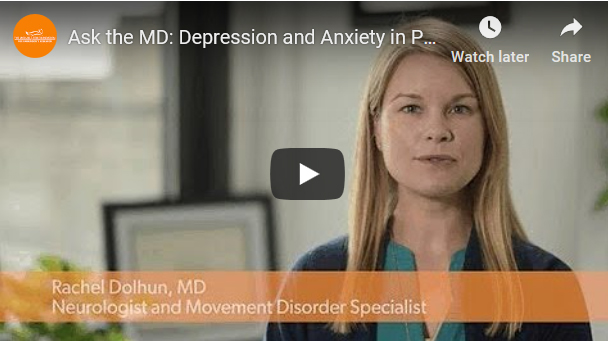Posted by Rachel Dolhun, MD,
I’m Doctor Rachel Dolhun. I’m movement disorder specialist and vice president of medical communications at The Michael J. Fox Foundation for Parkinson’s research.
Today I’ll be talking about depression and anxiety in Parkinson’s disease.
Depression and anxiety are common non motor symptoms associated with Parkinson’s disease.
They can occur at any time in the course of disease even before the diagnosis is made.
They can also occur independently of one another, but commonly they go hand in hand.
Symptoms of depression include decreased mood or energy, lack of interest in previously enjoyable activities, difficulty concentrating, slow thinking or even changes in weight, appetite or sleep.
A lot of the symptoms of depression can overlap with the symptoms of Parkinson’s which can make it difficult to determine what’s what.
Anxiety causes a lot of the same symptoms as depression but can also lead to uncontrollable worry or feelings of restlessness.
The levels of depression and anxiety in Parkinson’s, typically stay fairly constant but anxiety in particular can fluctuate. Some people will have more significant or severe episodes of anxiety, and sometimes this can even happen in conjunction with medication like Levodopa when you’re off at the end of a dose. If this is the case, symptoms will be somewhat alleviated with the next dose of your medication.
How are depression and anxiety treated?
Depression and anxiety can be treated with medications, counselling, or a combination of both.
It’s important to treat mood symptoms because they can decrease quality of life and make it more difficult to manage motor and non-motor symptoms in Parkinson’s.
The medication that are used to treat depression and anxiety in Parkinson’s are the same as those used to treat depression and anxiety in people who don’t have Parkinson’s. They work to regulate mood chemicals like serotonin, norepinephrine or dopamine.
The most commonly prescribed medications for depression and anxiety in Parkinson’s are what is known as SSRIS or selective serotonin reuptake inhibitors.
Examples of these would be Paxil which is known as paroxetine, or Prozac which is otherwise called fluoxetine.
Whichever medication is chosen, is started at a low dose, and then worked up gradually and continued for several weeks to see if it gives benefits. If it doesn’t work, another SSRIS may be chosen or doctors might prescribe from a completely different class of antidepressants.
Anti-depressants also work to treat anxiety but if a person has more significant episodes of anxiety or panic, they may be prescribed an as-needed-medication to take. This class of drugs is known as benzodiazepines and a common example would be Xanax or Alprazolam.
It’s important to use these medications cautiously in Parkinson’s disease as they could potentially worsen symptoms or cause side-effects like confusion, sleepiness or even imbalance.
Tips for managing depression and anxiety
In addition to talking with your doctor about treatment options, people who have depression or anxiety could benefit from exercising regularly, staying socially active to avoid isolation, and talking through symptoms with a loved one or a friend.
If you think your loved one might have depression or anxiety, you can help them by learning to recognize the signs and symptoms of these mood disturbances, by suggesting activities that you can do together so that they don’t isolate themselves, and also by offering support and listening as they talk through their symptoms.
You can learn more about this and other topics in Parkinson’s by visiting our website.

